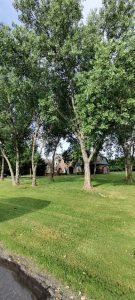As autumn settles in and temperatures begin to drop, it’s the perfect time to think about preparing your trees for the upcoming winter months. Pruning during this season not only promotes healthy growth but also ensures your trees can withstand the challenges that winter may bring. At Seraphim Total Home Business and Property Management, we understand the significance of proper tree care. Here’s why fall pruning is essential and how you can get started.
Why Pruning in Fall?
Pruning in late fall, after the leaves have fallen but before the first hard frost, offers several benefits:
- Disease Prevention: Removing dead or diseased branches reduces the risk of disease spread, as many pathogens are less active during colder months.
- Structural Integrity: Pruning helps shape the tree, removing weak or crossing branches that could break under the weight of snow or ice.
- Enhanced Growth: Proper pruning encourages healthy growth patterns, allowing trees to flourish when spring arrives.
Steps to Effective Fall Pruning
- Assess Your Trees: Begin by inspecting your trees for any dead, diseased, or damaged branches. Look for limbs that are crossing or rubbing against each other, as these can cause wounds and invite pests.
- Gather the Right Tools: Ensure you have sharp, clean pruning shears, loppers, or a pruning saw, depending on the size of the branches you’re targeting. Clean tools help prevent the spread of diseases.
- Make Proper Cuts: When removing branches, aim to cut just outside the branch collar—the swollen area where the branch meets the trunk. This technique promotes faster healing and reduces the risk of disease entry.
- Dispose of Debris: After pruning, collect and dispose of all cut branches and leaves. This practice prevents pests and diseases from overwintering in your yard.
Trees That Benefit from Fall Pruning
While many trees can be pruned in fall, it’s essential to know which ones will benefit most:
- Deciduous Trees: Species like oaks, maples, and birches are ideal candidates for fall pruning. Removing dead or diseased branches helps prevent disease spread and promotes healthy growth.
- Fruit Trees: Pruning fruit trees in late fall can enhance fruit production. However, avoid heavy pruning of stone fruits like cherries and plums during this time, as they can be more susceptible to disease.
When to Avoid Fall Pruning
Some trees are best pruned at different times of the year:
- Spring-Flowering Trees: Trees that bloom in spring, such as lilacs and forsythias, should be pruned immediately after flowering to avoid cutting off next year’s flower buds.
- Evergreens: While light shaping is acceptable, avoid heavy pruning of evergreens in fall, as it can lead to winter burn.
Let Seraphim Total Home Business and Property Management Assist You
Proper tree care requires knowledge and attention to detail. If you’re unsure about how to prune your trees or prefer professional assistance, Seraphim Total Home Business and Property Management is here to help. Our team of experts can assess your property’s needs and ensure your trees are healthy and well-maintained throughout the year.
Contact us today to schedule a consultation or learn more about our services.







